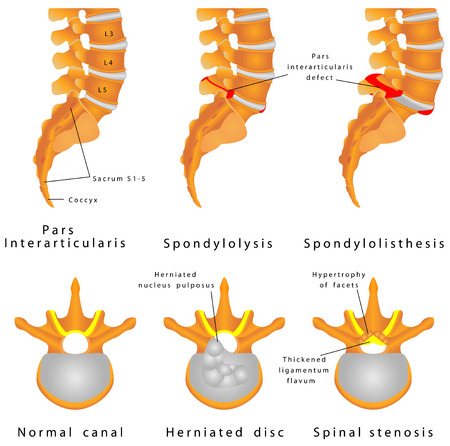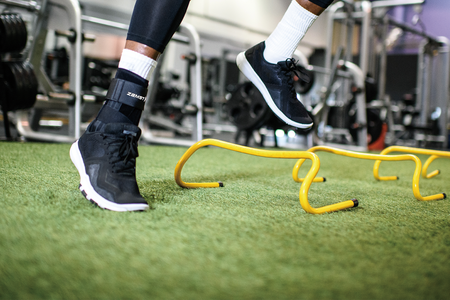What it is: A spinal condition in which one of the spinal vertebrae slips out of alignment.  Depending on the amount of slippage, the vertebrae could compress a nerve, resulting in back pain. Typically, the vertebrae of the low back (lumbar) region are more affected. This is the most common cause of low back pain in teenagers.
Depending on the amount of slippage, the vertebrae could compress a nerve, resulting in back pain. Typically, the vertebrae of the low back (lumbar) region are more affected. This is the most common cause of low back pain in teenagers.
Different types of spondylolisthesis:
- Congenital: present at birth; bone deformation
- Isthmic: results from spondylolysis (fracture of the vertebrae); most common at L5
- Degenerative: *most common; typically due to disc degeneration between the vertebrae. Usually not seen until after age 40.
- Pathological: vertebrae are weakened due to disease (osteoporosis, tumor, infection)
Symptoms: Often, no symptoms are present (especially if nerve isn’t compressed). Most common symptom is low back pain. If a nerve is compressed, muscle spasms through the back and legs (hamstrings) may occur, and tingling or numbness may be felt through one or both legs.
Grading classifications: The severity of the condition is based upon the percent of slippage seen on an x-ray. Grade I is the less severe (< 25% slippage), and while Grade IV is the most severe (75-99% slippage), rarely a spondyloptic vertebrae is seen (100% detached). Grade I slippage makes up > 75% of diagnosed patients.
Treatment: Varies depending on severity of slippage and associated pain. Conservative: Rest from physical activities may be warranted until pain subsides. Pain medication may be used, and sometimes a brace or some sort of back support is recommended. Physical therapy: PT is recommended to help decrease pain, reduce muscle spasm and flexibility impairments, and to increase core strength (spinal stabilization training). Conservative treatment with PT for mild cases is successful in around 80% of cases. Surgery: Typically, Grade I and II do not require surgery, which is only warranted if pain does not decrease with conservative treatment or if the vertebrae continues to slip.
Avoid: Avoiding hyperextension (excessive back bend) is generally recommended. Additionally, it is recommended to avoid sports or activities that put excessive stress (load) through the spine while it is extended. The best way to avoid this condition is to maintain a strong back and core, maintain a healthy weight, and to avoid the above mentioned activities.

Alyson Kessner, PT, DPT, CSCS
ProSport STACK Sport Performance and Therapy
2777 Bristol St, Ste B, Costa Mesa, CA 92626
Reference: Weinstein JN, Lurie JD, Tosteson TD, et al. “Surgical Compared with Nonoperative Treatment for Lumbar Degenerative Spondylolisthesis.” J Bone Joint Surg Am, 2009; 91: 1295-1304







2 comments
I am fairly much amazed with the article content.I realized a good deal in the fantcsaiing topics which are becoming discussed. It’s my pleasure to visit and realized issues and details of this page.I is going to be going to this web site extra typically for I’m extremely intrigue with the topic that certainly catches my interest.
Thank you Hallie! We really appreciate your feedback.